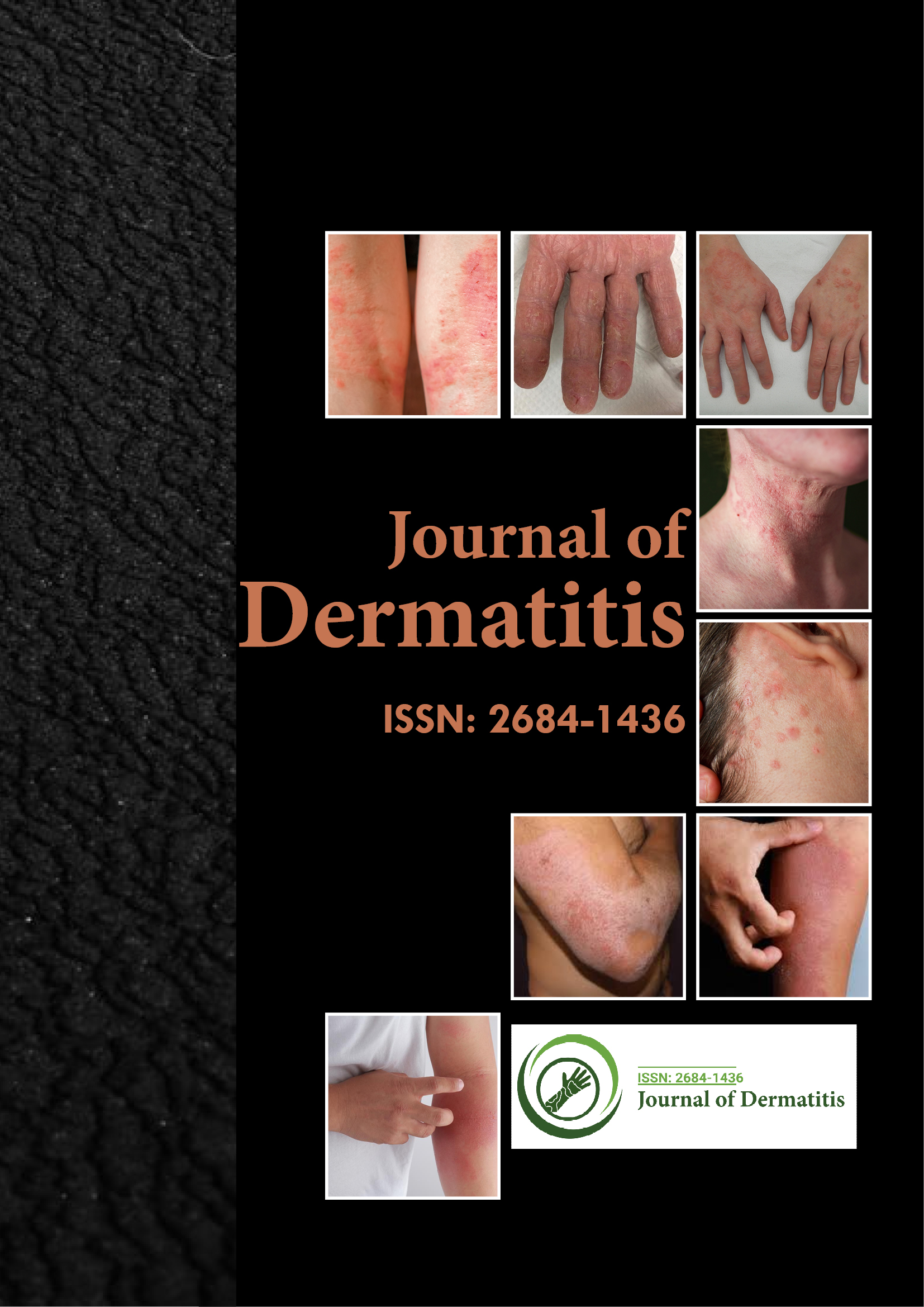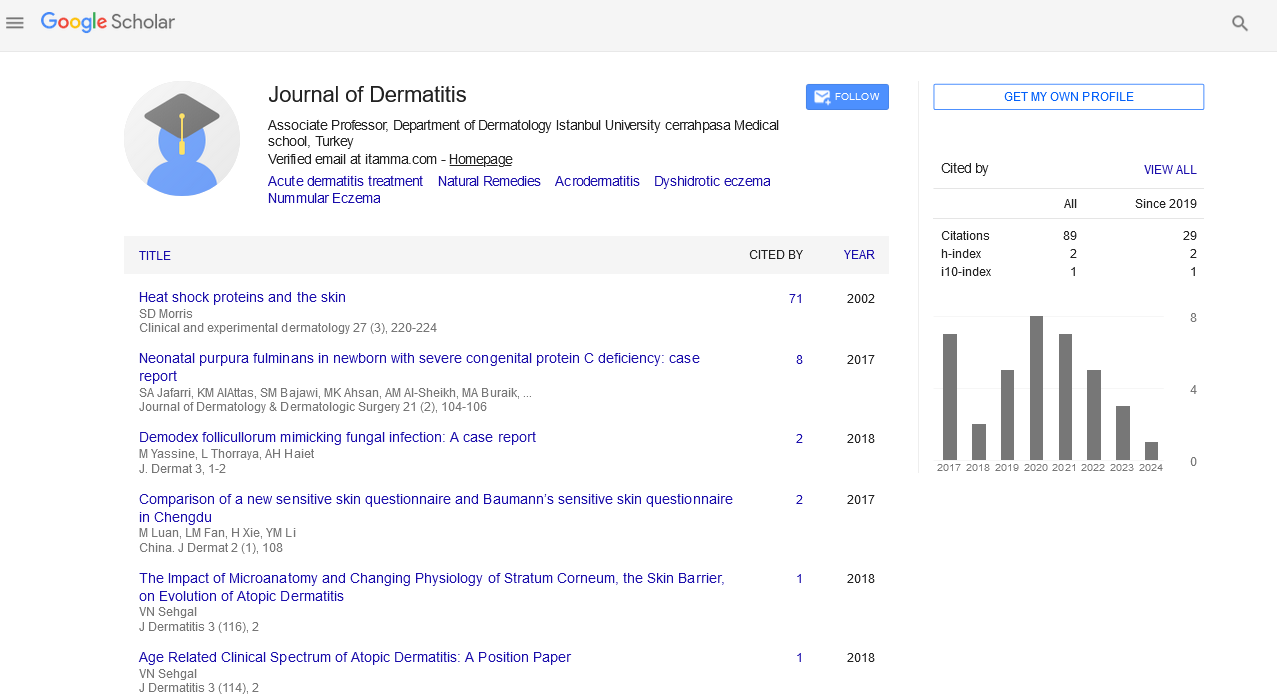Indexed In
- RefSeek
- Hamdard University
- EBSCO A-Z
- Euro Pub
- Google Scholar
Useful Links
Share This Page
Journal Flyer

Open Access Journals
- Agri and Aquaculture
- Biochemistry
- Bioinformatics & Systems Biology
- Business & Management
- Chemistry
- Clinical Sciences
- Engineering
- Food & Nutrition
- General Science
- Genetics & Molecular Biology
- Immunology & Microbiology
- Medical Sciences
- Neuroscience & Psychology
- Nursing & Health Care
- Pharmaceutical Sciences
Short Communication - (2024) Volume 9, Issue 2
Targeting ADAM10 and ADAM17 to Restore LAG3 Function in Psoriasis Treatment
Isabella Rossi*Received: 29-May-2024, Manuscript No. JOD-24-27951; Editor assigned: 31-May-2024, Pre QC No. JOD-24-27951 (PQ); Reviewed: 14-Jun-2024, QC No. JOD-24-27951; Revised: 21-Jun-2024, Manuscript No. JOD-24-27951 (R); Published: 28-Jun-2024, DOI: 10.35248/2684-1436.24.9.242
Description
Psoriasis is a chronic, autoimmune skin disease characterized by hyperproliferation of keratinocytes and inflammatory responses mediated by T cells [1]. Despite advances in the understanding of its pathogenesis, psoriasis remains a challenging condition to treat, particularly because of its complex immune dysfunction. One important feature of psoriasis is the dysfunction of immune regulatory mechanisms, including the impairment of immunosuppressive pathways that are typically regulated by checkpoint receptors like LAG3 (Lymphocyte Activation Gene-3). LAG3 is known to inhibit T cell activation and its function is essential for maintaining immune homeostasis. Recent studies have pointed to the role of ADAM10 and ADAM17, two members of the ADAM (a disintegrin and metalloprotease) family, in regulating LAG3 immunosuppressive, suggesting that the disruption of LAG3’s immunosuppressive activity could be central to the pathogenesis of psoriasis [2,3].
LAG3 is a critical immune checkpoint receptor expressed on activated T cells, regulatory T cells (Tregs) and other immune cells. It works by binding to MHC class II molecules, delivering inhibitory signals that reduce T cell activation and help maintain immune tolerance. This inhibition plays an essential role in controlling autoimmunity and preventing excessive inflammatory responses. However, in psoriasis, this regulation is often impaired, leading to uncontrolled immune activation and skin inflammation [4,5]. ADAM10 and ADAM17 are metallo proteases that are involved in the shedding of membrane-bound proteins from the cell surface, a process known as ectodomain shedding. These enzymes cleave the extracellular domain of a variety of substrates, including cytokine receptors, adhesion molecules and immune checkpoint receptors such as LAG3. The shedding of LAG3 by ADAM10 and ADAM17 is of particular interest in psoriasis, as it potentially leads to the release of soluble LAG3, which may impair the immunosuppressive functions of LAG3 and promote a proinflammatory environment.
Recent findings suggest that ADAM10 and ADAM17-mediated cleavage of LAG3 could contribute to the impairment of immunosuppressive pathways in psoriasis [6]. By shedding the extracellular domain of LAG3, these proteases may reduce the number of functional LAG3 molecules available on the surface of T cells, particularly Tregs, which are essential for regulating immune responses. This reduction in LAG3 activity could lead to an inability to control T cell activation, exacerbating the inflammatory response that is central to psoriasis pathogenesis. The potential role of ADAM10 and ADAM17 in the pathogenesis of psoriasis opens up new therapeutic methods. Inhibiting the activity of these proteases could restore LAG3 function, promote immunosuppressive signaling and reduce the excessive T cell activation seen in psoriasis [7]. Targeting ADAM10 and ADAM17 could help reinstate immune tolerance and possibly lead to more effective treatments for psoriasis, particularly in cases where traditional immune-modulating therapies are insufficient [8].
In addition to their role in releasing LAG3, ADAM10 and ADAM17 are also involved in the processing of other important molecules that regulate immune responses, such as TNF receptors and various cytokine receptors. The activity of these proteases in psoriasis may not be limited to LAG3 alone but could extend to other immune checkpoints and inflammatory mediators, further reducing the disease process. Understanding the major scope of ADAM10 and ADAM17’s involvement in psoriasis could provide insight into how these enzymes affect multiple pathways of immune regulation. Furthermore, targeting both the release of LAG3 and other immune-related molecules by ADAM10/17 could lead to a more comprehensive approach to managing psoriasis and potentially other autoimmune diseases with similar immune dysregulation. Therefore, exploring these proteases as therapeutic targets could yield significant clinical benefits by restoring immune balance and mitigating chronic inflammation [9,10].
Further studies are needed to better understand the precise mechanisms by which ADAM10 and ADAM17 contribute to psoriasis and other inflammatory diseases. Additionally, investigating the potential therapeutic benefits of ADAM10 and ADAM17 inhibitors could lead to novel treatments that target immune dysregulation in psoriasis. The role of soluble LAG3 and its interaction with other immune molecules should also be explored, as it may provide insight into how LAG3 cleavage contributes to the inflammatory microenvironment in psoriasis.
Conclusion
In conclusion, addressing the challenges posed by multidrugresistant Gram-negative bacilli in skin infections requires a multifactorial approach that includes historical knowledge, current research and innovative strategies. Although significant progress has been made in understanding and combating these pathogens, much remains to be done to ensure effective management, especially given the growing threat of antimicrobial resistance. Collaborative efforts across disciplines will be essential in the fight against multidrug-resistant infections.
References
- Agarwal P, Wolfe SM, Sanabria B, Pathak GN, Alamgir M, Rao BK. Evaluating the role of the gut microbiota in autoimmune skin diseases: A scoping review. JAAD Reviews. 2024;2:67-73.
- Yu Z, Tang X, Chen Z, Hu Y, Zhang S, Guo C, et al. Role of ADAM10/17-mediated Cleavage of LAG3 in the Impairment of Immunosuppression in Psoriasis. J Invest Dermatol. 2024;S0022-202X(24)02948-8.
[Crossref] [Google Scholar] [PubMed]
- Duffy MJ, Crown J, Mullooly M. ADAM10 and ADAM17: New players in trastuzumab resistance. Oncotarget. 2014;5(22):10963.
[Crossref] [Google Scholar] [PubMed]
- Keith YH, Egawa G, Honda T, Kabashima K. Mast cells in type 2 skin inflammation: Maintenance and function. Eur J Immunol. 2023;53(8):2250359.
[Crossref] [Google Scholar] [PubMed]
- Zhang Y, Lu Q. Immune cells in skin inflammation, wound healing, and skin cancer. J Leukoc Biol. 2024;115(5):852-65.
[Crossref] [Google Scholar] [PubMed]
- Xu H, Zhang X, Wang X, Li B, Yu H, Quan Y, et al. Cellular spermine targets JAK signaling to restrain cytokine-mediated autoimmunity. Immunity. 2024;57(8):1796-1811.
[Crossref] [Google Scholar] [PubMed]
- Griffiths CE, Barker JN. Pathogenesis and clinical features of psoriasis. Lancet. 2007;370(9583):263-71.
[Crossref] [Google Scholar] [PubMed]
- Tokuyama M, Mabuchi T. New treatment addressing the pathogenesis of psoriasis. Int J Mol Sci. 2020;21(20):7488.
[Crossref] [Google Scholar] [PubMed]
- Yu Y, Chen Z, Wang Y, Li Y, Lu J, Cui L, et al. Infliximab modifies regulatory T cells and co-inhibitory receptor expression on circulating T cells in psoriasis. Int Immunopharmacol. 2021;96:107722.
[Crossref] [Google Scholar] [PubMed]
- Gertel S, Polachek A, Elkayam O, Furer V. Lymphocyte activation gene-3 (LAG-3) regulatory T cells: An evolving biomarker for treatment response in autoimmune diseases. Autoimmun Rev. 2022;21(6):103085.
[Crossref] [Google Scholar] [PubMed]
Citation: Rossi I (2024). Targeting ADAM10 and ADAM17 to Restore LAG3 Function in Psoriasis Treatment. J Dermatitis. 9:242.
Copyright: © Rossi I. This is an open access article distributed under the terms of the Creative Commons Attribution License, which permits unrestricted use, distribution, and reproduction in any medium, provided the original author and source are credited.

